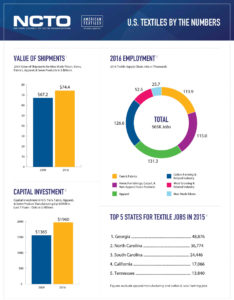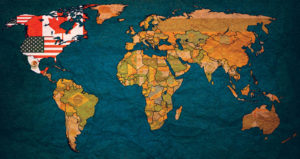
As a presidential candidate, Donald Trump promised to improve U.S. trade deals, including the North American Free Trade Agreement (NAFTA). Since taking office and subsequently threatening to withdraw the United States from NAFTA unless the terms were renegotiated, Mexico and Canada have been cajoled to revisit the deal.
The first round of tripartite talks commenced in Washington, D.C., on August 16, the day after the U.S. statutorily mandated comment and congressional consultation period expired. The quick start set a marker for the administration’s intention to move expeditiously in this effort. An additional round was held in Mexico City over Labor Day weekend. Regarding textiles, the talks have largely been focused on a technical discussion and information exchange rather than getting into substantive decision-making.
NAFTA’S importance
Key political issues in the textile arena are expected to center around rules of origin and, more specifically, derogations from the industry-standard “yarn forward” rule. The textile sector’s message to the administration on NAFTA has made its position clear:
- The agreement is vital to U.S. textile manufacturing prosperity.
- It agrees with the administration that the deal can and should be improved.
NAFTA is crucial to the U.S. textile industry because Mexico and Canada are its two largest trade partners. Two-way trade between the United States and its NAFTA partners was $18.6 billion in 2016, up from $7.3 billion in 1993, the year before the agreement was implemented. Moreover, this trade generated a $3.5 billion trade surplus for the U.S. last year.
The NAFTA region enjoys vibrant fiber, yarn and fabric sectors in addition to end product assembly capabilities. An outright cancellation of NAFTA would be highly disruptive because of the level of supply chain integration in the region. As for improving NAFTA, the U.S. textile industry’s overarching request to the Trump administration is to build upon the successes of NAFTA through commonsense adjustments that would enhance U.S. production, exports and employment. There are three specific issues that should be addressed.
Customs enforcement
The U.S. must have a stronger focus on and commit greater resources to customs enforcement. During the past 30 years, there has been a systematic de-emphasis on commercial fraud enforcement at U.S. Customs and Border Protection (CBP). CBP suffers from a lack of both resources and focus, especially considering the uptick in the number of trade agreements and overall trade flows during this time frame. Consequently, the benefits of these agreements have been siphoned off by third-party countries and importers willing and able to circumvent U.S. trade laws and agreements.
No exceptions
The U.S. should eliminate exceptions to yarn forward in the NAFTA rule of origin. Every U.S. free trade agreement (FTA) includes what is known as “rules of origin” that define which steps must be undertaken for a product to be considered an originating product and qualify for the duty preferences afforded by the agreement. The standard rule of origin for textiles in nearly all U.S. FTAs is the yarn-forward rule, which requires yarn and every manufacturing step following the yarn stage to be done in the FTA region.
Yarn forward was originally devised under NAFTA and is the accepted rule of origin for the domestic textile industry because it reserves key benefits for manufacturers within the signatory countries. A yarn-forward concept is also markedly easier to enforce vs. a value-added rule of origin. Although most U.S. FTAs are built on yarn forward as the basic structure, exceptions to the rule exist in many agreements that shift business away from U.S. producers to FTA parties, in particular to China.
These yarn-forward loopholes take many forms, with the most egregious being tariff preference levels (TPLs), an exception allowing for a specific quantity of goods to be shipped duty free among free trade partner countries, even though some or all of the components therein are sourced from countries that are not signatories to the agreement.
Under NAFTA, Mexico is permitted to ship annually up to the equivalent of 24 million square meters (SME) of certain fabrics and made-up textile articles, including synthetic fiber industrial products, to the U.S. duty free. Canada has a 72 million SME TPL for this category of articles. There are three additional TPLs for cotton and synthetic fiber yarns, cotton and synthetic fiber apparel, and wool apparel. These and other loopholes should be eliminated in any renegotiation.
Close loopholes
The loophole that dilutes the Kissell Amendment needs to be closed. The Kissell Amendment, 6 USC 453b, is a Berry Amendment–like “Buy American” law for textiles that applies to the Department of Homeland Security (DHS). In practice, however, the DHS only applies Kissell to purchases by the Coast Guard and Transportation Security Administration (TSA) because of U.S. commitments made under the World Trade Organization (WTO) Revised Agreement on Government Procurement (GPA).
With respect to its application to the TSA, Kissell has further been diluted. This is because the U.S. government failed to notify Mexico and Canada under NAFTA, as well as Chile under the Chilean FTA, that the United States was reserving the TSA from the GPA when the TSA was created. Accordingly, the U.S. has taken the position that those countries are acceptable as U.S. sources under Kissell. This oversight should be rectified in any NAFTA renegotiation.
Current status
It is not clear when the talks will progress to the decision-making stage; however, an aggressive meeting schedule was set in fall 2017. With this accelerated pace, the hope was to wrap up the renegotiation by early 2018 to avoid political complications given Mexico’s presidential election next summer, U.S. midterm elections and the expiration of trade promotion authority. It is unclear if this goal will prove attainable, but it is viewed as ambitious, given the usual pace of trade negotiations.
Regardless of whether the talks are finalized by the end of the year, the U.S. government is moving quickly in this effort. The Trump administration released its NAFTA negotiating objectives during the summer of 2017 and has offered specific proposals for changes to the various chapters of the agreement’s text. Given the NAFTA trade volumes for textiles and significant supply chain integration, the NAFTA modernization effort could have a major impact on the industry. As a result, engagement with Washington decision-makers continues to be critical.
Sara Beatty and Lloyd Wood are the Washington representatives for IFAI’s USIFI and NFI divisions. They each have 14 years’ experience advocating on behalf of domestic textile manufacturers.
IFAI’s U.S. Industrial Fabrics Institute (USIFI) and Narrow Fabrics Institute (NFI) divisions are on record strongly encouraging an increased emphasis on customs enforcement of NAFTA and other free trade agreements. The administration and Congress should devote additional resources to more effectively enforce U.S. trade laws and duty assessments, which will not only pay for itself, but also generate new revenues. USIFI and NFI are collecting and providing input to the administration, as well as keeping member companies abreast of significant developments, and welcome additional members who share the goal of strengthening the terms for U.S. production. For more information, visit https://narrowfabrics.ifai.com and https://usindustrialfabrics.ifai.com.
 TEXTILES.ORG
TEXTILES.ORG



